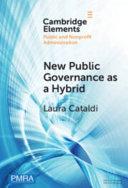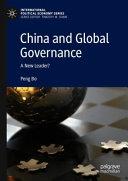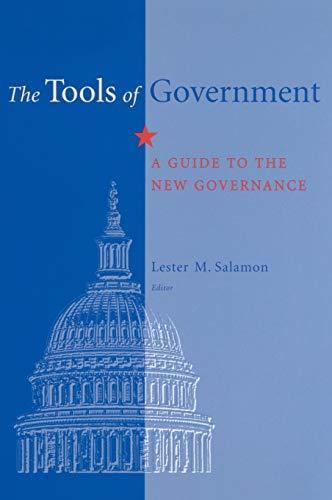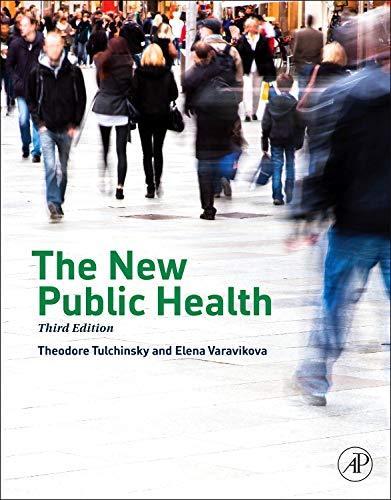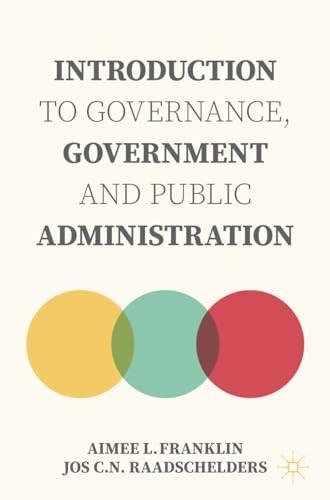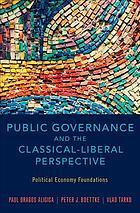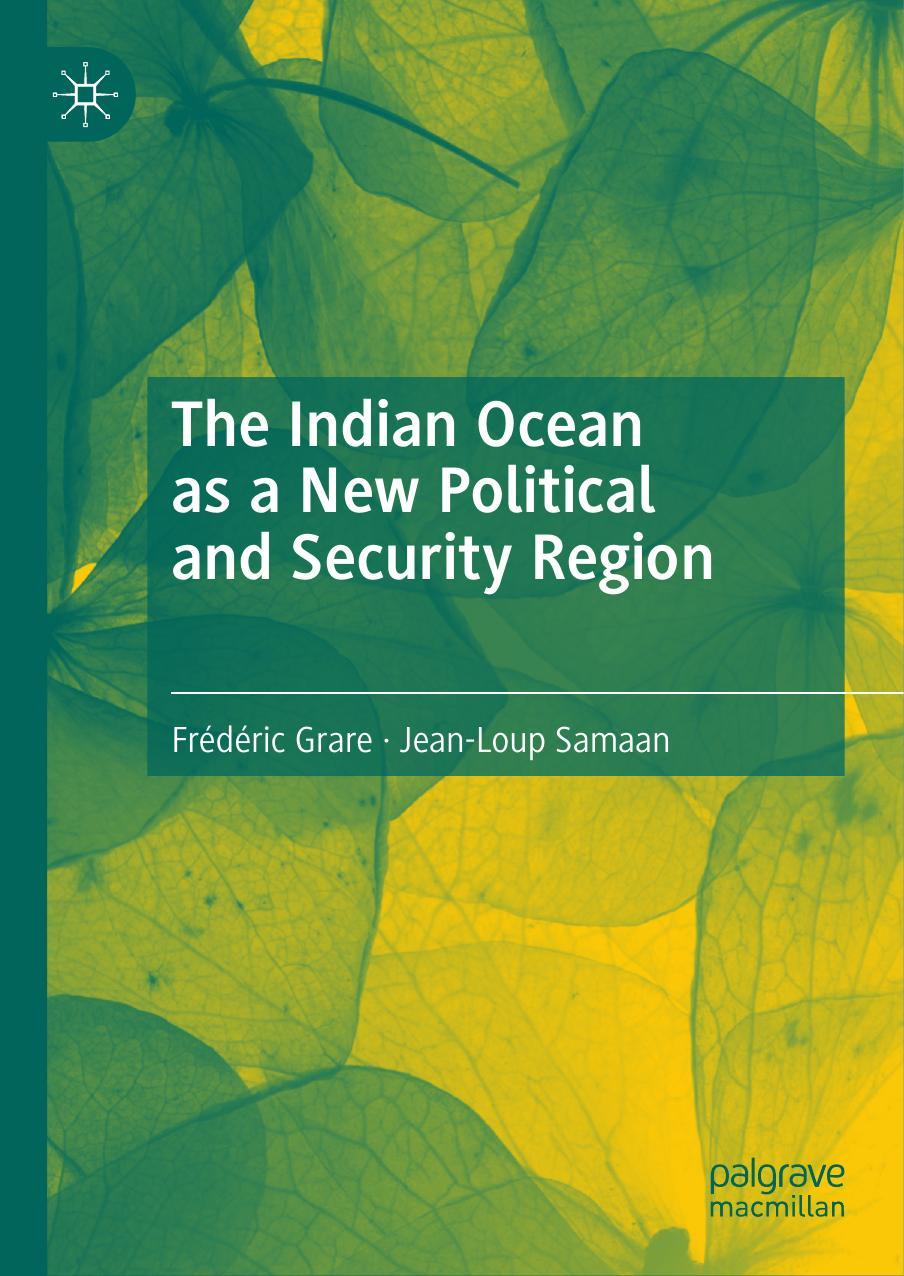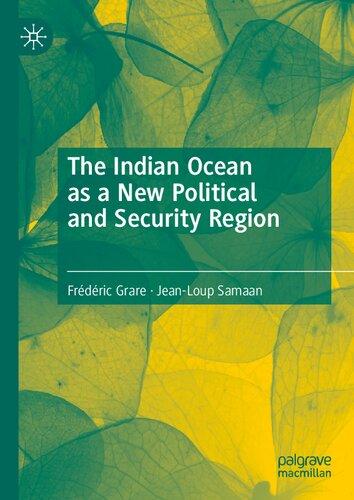New Public Governance as a Hybrid
Laura Cataldi
ElementsinPublicandNonprofitAdministration
editedby
AndrewWhitford
UniversityofGeorgia
RobertChristensen
BrighamYoungUniversity
NEWPUBLIC
GOVERNANCE
ASAHYBRID
ACriticalInterpretation
LauraCataldi
UniversityofEasternPiedmont
ShaftesburyRoad,CambridgeCB28EA,UnitedKingdom OneLibertyPlaza,20thFloor,NewYork,NY10006,USA 477WilliamstownRoad,PortMelbourne,VIC3207,Australia
314–321,3rdFloor,Plot3,SplendorForum,JasolaDistrictCentre, NewDelhi – 110025,India
103PenangRoad,#05–06/07,VisioncrestCommercial,Singapore238467
CambridgeUniversityPressispartofCambridgeUniversityPress&Assessment, adepartmentoftheUniversityofCambridge.
WesharetheUniversity’smissiontocontributetosocietythroughthepursuitof education,learningandresearchatthehighestinternationallevelsofexcellence.
www.cambridge.org Informationonthistitle: www.cambridge.org/9781009454032
DOI: 10.1017/9781009418904
©LauraCataldi2024
Thispublicationisincopyright.Subjecttostatutoryexceptionandtotheprovisions ofrelevantcollectivelicensingagreements,noreproductionofanypartmaytake placewithoutthewrittenpermissionofCambridgeUniversityPress&Assessment. Whencitingthiswork,pleaseincludeareferencetotheDOI 10.1017/9781009418904
Firstpublished2024
AcataloguerecordforthispublicationisavailablefromtheBritishLibrary.
ISBN978-1-009-45403-2Hardback
ISBN978-1-009-41892-8Paperback
ISSN2515-4303(online)
ISSN2515-429X(print)
CambridgeUniversityPress&Assessmenthasnoresponsibilityforthepersistence oraccuracyofURLsforexternalorthird-partyinternetwebsitesreferredtointhis publicationanddoesnotguaranteethatanycontentonsuchwebsitesis,orwill remain,accurateorappropriate.
ACriticalInterpretation
ElementsinPublicandNonprofitAdministration
DOI:10.1017/9781009418904
Firstpublishedonline:January2024
LauraCataldi
UniversityofEasternPiedmont “AmedeoAvogadro”
Authorforcorrespondence: LauraCataldi, laura.cataldi@uniupo.it
Abstract: ThisElementfocusesonNewPublicGovernanceasoneof themajoradministrativenarrativesofourtimes.Itoffersacritical interpretationofNPGasahybridtoolformanagement,governance, andreform,arguingthatNPGcoexistswithandislikelytogradually mergeintoNewPublicManagement.Severalargumentssupportthe “continuityandhybridization” hypothesis,wherebythetransitionfrom NPMtoNPGoccurredthroughtheretentionofkeyelementsand alayeringandsedimentationprocess.Theseargumentschallengethe “linearsubstitution” hypothesis,accountingforNPM’spersistenceand dominance.TheElementdevelopsanewinterpretationofNPGand discussesthechallengesthatNPGposes.Finally,itshowsthatexploring hybridityiscriticalforevaluatingthepotentialofNPGintermsofashift inpublicadministrationandunderstandinggovernancetrajectories andreformscenarios.
Keywords: newpublicgovernance,newpublicmanagement,hybridization, narratives,state
©LauraCataldi2024
ISBNs:9781009454032(HB),9781009418928(PB),9781009418904(OC) ISSNs:2515-4303(online),2515-429X(print)
1Introduction
ThisElementfocusesonNewPublicGovernance(NPG)asoneofthemajor administrativenarrativesofourtimes.Basedonawiderangeofexisting literature,itoffersacriticalinterpretationofNPGasa “hybrid” narrativeobject and,specifically,amanagement,governance,andreformtool.Indeed,itargues thatNPGcoexistswithandislikelytograduallymergeintoNewPublic Management(NPM),thecompetingandhithertodominantnarrativeofthe publicsector ’smanagement,governance,andreform.
Inthisintroduction,preliminarydefinitionsofNPMandNPG,aswellas “hybridization” anditsrelatedconcepts,arerequiredanduseful.
As DenhardtandDenhardt(2000,550)write, “the ‘NewPublic Management’ referstoaclusterofideasandpracticesthatseek,attheircore, touseprivate-sectorandbusinessapproachesinthepublicsector” (seealso Haynes2003).Instead,NPG “isaholistic,networkedapproachtotheinstitutionalrelationshipswithinsocietytounderstand,develop,andimplement publicpolicywithinapluraliststate” (Youngetal.2020,482).
Regarding “hybridization” anditsrelatedterms,definitionscouldbeprovidedstartingfromthebiologicaloriginsoftheconceptsanddrawingfrom arapidlyexpandingbodyofliterature,particularlyinthe fieldofpublic administrationandgovernance(interal., Aristovniketal.2022; Battilana etal.2017; Brandsenetal.2005; Brandsen2010; Denisetal.2015; Skelcher 2012).Withinthiscontext, “hybrids” areobjects – entities,organizations, systems,andevennarratives – thatcombine(mix,orblend)elements.These elementsincludecharacteristics,features,principles,andlogicsfromdifferent andsometimescontrastingsources,suchasmodels,idealtypes,archetypes, paradigms,and,morebroadly,worldsanddomains.Hybridityisthepropertyof theseobjects,denotingthestateofbeinghybrid,characterizedbythecoexistenceandcombinationofdiversecomponents,whichcangiverisetotensions andpossiblecontradictions(Denisetal.2015; Glynnetal.2020).Lastly, hybridizationisthe(combination,mixing,orblending)processthatgivesrise tohybridityasapropertyandageneralphenomenonrelatedtohybridobjects. Theconceptof “hybridity” isdistinguishedbyitsprocessual,aswellasbroadly “transitional” character(Brandsen2010,840),anditopposestheconceptof “purity” (KrlevandAnheier2020).Asobservedby Brandsen(2010,840), “in publicadministrationresearch,” hybridity “tendstodenotepublic/privatemixes [...],whereasinorganizationaltheoryitgenerallyreferstocombinationsof coordinationmechanismssuchashierarchies,markets,andnetworks.”
Inlightofwhathasbeensaid,hybridizationistobeunderstood,ingeneral,as aprocessthatinvolvesthepublicsectorandoccursbetweenthestate,intended
asgovernment,aswellas “public” and “hierarchy,” andwhatis “otherthanthe state” (i.e.,marketandnetworksas “nonpublic,”“nongovernmental,” and “private” latosensu).However,inthisElement,hybridizationismorespecificallytheprocessthatpertainstoNPGasanadministrativenarrativeandoccurs betweenNPGanditspredecessor,NPM.
Osborne(2006,377),theinventorofthetermNPGandinitiatorofthisnew publicnarrative,provocativelyarguedthat,inpublicadministrationandmanagement, “NPMhasactuallybeenatransitorystage” intheevolutionfrom TraditionalPublicAdministration(TPA)toNPG,addingthatNPMhasoccupied “arelativelybrief” time “betweenthestatistandbureaucratictraditionof PAandtheembryonicpluralandpluralisttraditionoftheNPG.” After Osborne’sarticle, “greatdebateensuedamongscholarsonhowNPGshould bedefined,andhowitvariesfromNPM” (Youngetal.2020,482).
Undoubtedly, “theconsiderablevariationsinobservablegovernancepracticesattributabletocontext-specificdifferencesandthechoiceofanalytical categoriesfordescribingsuchpractices” (WieselandModell2014,201,note1) makeNPG “object” verycomplextocapture.Accordingto Koppenjanand Koliba(2013,2), “NPGmaybeanumbrellaconceptunderwhichalargevariety ofgovernanceinnovationsareassignedthatmayhavelittleincommon.” Furthermore,as Liddle(2018,971)pointsout, “theconceptofNPGhasbeen criticizedforitsfuzzinessandforbeingusedinsubstantiallydifferentways(as apracticalornormativeconcept)andamidstdivergingdiscussions” indifferent socialsciences fields,includingpublicadministration.
Therefore,oneofthemainobjectivesofthiscontributionistoidentify astrategytocaptureNPGasanarrativeobjectinordertoevaluateitspotential intermsofashiftinpublicadministrationandpublicsectorreforms.Forthis purpose,itisnecessarytodiscussthesupposedlyoppositivenatureofNPGto itspredecessorNPM,aswellastotakeanarguedpositiononthescholarly debateabouttheirrelationship,engagingwiththemostsignificanthypotheses presentintheliterature.Thus,keyresearchquestionsare:IsNPMreally passé (HyndmanandLapsley2016)ordead,assomescholars(see Dunleavyetal. 2006)andpoliticians(seetheDanishSocialDemocraticPrimeMinister,Mette Frederiksen – Kroghetal.2022)argue?WillNPGreplace,transform,orcoexist withNPM?
TheElementarguesthat,althoughNPGreallyhasareactiveorigintoNPM, itsoppositivenature(i.e.,itsirreconcilabilitywithNPM’sfundamentaltenets andideas)hasbeensomehowpurposelyoveremphasizedtolegitimizethenew narrativeinthefaceofthefailuresofthehithertodominantnarrative,NPM.
AlthoughNPGoriginatedasacounternarrativetoNPM,severalarguments willbebroughttosupportoneofthetwomajorhypothesesintheliterature
regardingtherelationshipandtransitionbetweenNPMandNPG,namelythe “continuityandhybridization” one.Accordingtothishypothesis,thetransition fromNPMtoNPGtookplacethrough “theretentionofkeyelements” (Wiesel andModell2014,180)foundinpreviousgovernancemodels,suchasNPMand TPA,largelyviaalayeringandsedimentationprocess(MahoneyandThelen 2010; StreeckandThelen2005;seealso Dickinson2016; HyndmanandLiguori 2016; Ongaro2009; Torfingetal.2020).Thecoexistenceofthese “old” elementswithinNPGincombinationwith “new” featuresispreciselywhat makesNPGahybrid.Theseargumentschallengethe “linearsubstitution” hypothesis,wherebyawholenewgovernanceperspectivehassupplanted NPM(DenhardtandDenhardt2000; Dunleavyetal.2006; Entwistleand Martin2005),positingradicalchangeifnotsubversion.Therefore,the Element,providinganoriginalconstructionofargumentsinfavorofthe “continuityandhybridization” hypothesis,ultimatelyendorsestheoverarching observationof Aristovniketal.(2022,3),highlightingthat “whenaparticular newmodelisembraced,itisnotverylikelythatitwilldirectlyreplaceallofthe previousmechanisms,principles,ideas,andpractices.Throughouthistory,new modelshaveemerged,andnewdevelopmentshaveaccumulated,yetspecific trendsoftheearliermodelsremainrelevantandarenowintertwinedwiththe newideas.”
Inthiscontext,characterizingNPGasahybridmeansunveiling,beyond rhetoric,itsnotcomplete “otherness” fromNPM,highlightingelementsand reasonsforcontinuityamidstchange,anddiscussingthepotentialtensionsand challengesthatNPGasahybridposes.Thisisespeciallyrelevantintermsof democraticgovernanceasNPGpromisesare-politicizationandredemocratizationofthepublicsectorafterwhatiswidelyrecognizedas aperiodofdestructivedominancebyNPM.
Gettinginvolvedinaratherheatedandpopulateddiscussionsuchastheone ontherelationshipbetweenNPMandNPGisimportanttounderstandthe evolutionsingovernance,publicmanagement,andreformprocesses.So, otherresearchquestions,whichwillbeaddressedintheconclusions,are: Whataretheimplicationsofthishybridizationprocessinandbetweenadministrativenarratives?Whatgovernance,administrativeandreformscenariosare emerging?Inwhichdirectiondonarrativesandreformtrajectoriesseemtogo?
Lastly,twoclarificationsareneeded.First,althoughthisElementconsiders NPGa “narrativeobject,” itdoesnotproposeatypicalnarrativeordiscourse study.Instead,itoffersaconceptualanalysis,builtuponanextensivebodyof literature,ofNPGasanarrativetoolorientedtothepublicsector ’smanagement,governance,andreform.Thisanalysisisalignedwiththeperspectiveof the “interpretivepublicadministration” (BevirandRhodes2022; Needham
2015; Rhodes2019)asitproposesa(criticalandsubjective)interpretationanda “story” ofotherinterpretationsand “stories” (BevirandRhodes2003,133; Needham2015,340).Second,whenconsideringNPGanarrativeobjectand reformtool,theanalysispresentedheremainlyaddressestheworldofideas. Indeed, Jann’s(2003,95–96) caveat appliestothisElementaswell:the contribution “isnotabout ‘real’ changes,different ‘trajectories’ ofpublicsector reformandtheiroutcomes,butaboutthebeliefs,problemdefinitionsand recommendedsolutionsthatinspirethe ‘real’ changesor ‘trajectories’ ofpublic sectorreform.” Yet,lookingatnarrativesisfundamentalnotonlybecause “this allowsustomentallymapwherewehavebeen,” thatis, “torecognizehowwe arrivedatthesituationwearein” and “wherewearegoingto” (Massey2019, abstractand9),butalsobecauseadministrativeandgovernancenarrativessuch as “ideationalconstructions” have “arealimpactonadministrativepractices andtheformandfunctioningofpublicorganizations” (Torfingetal.2020,11), aswellas,ultimately,onallofusascitizens.
TheElementisstructuredasfollows.AfterIntroduction, Section2 explains whatadministrativenarratives,likeNPG,areandwhyitisimportanttolookat themasmanagement,governance,andreformtools. Section3 outlinesand discussesthechoiceofatwofoldstrategyto “ capture ” NPGandnarrative governancetrajectories.Thefollowing sectionsgettotheheartofthedebate onNPGanditsrelationshipwithNPM. Section4 providescoordinatesto understandtheNPGobject,suchasacounternarrativeofNPM inprimis. Section5 presentsthetwohypothesesintheliteratureregardingtherelationshipbetweenNPGandNPM,takingapositioninfavorofthe “ continuityand hybridization ” byillustratingsourcesofcontinuityandelementsthatmake NPGahybrid. Sections6 and 7 outline,respectively,thereasonsforNPG hybridizationwithNPMandNPMpersistence/dominance.Theconcluding sections(8),afterasummaryofthe “NPGasahybrid ” arguments(8.1), highlighttheoriginsandcomplexitiesofadministrativenarratives’ hybridity withspecialreferencetoNPG(8.2),re fl ectonthepossiblereformscenarios (8.3)and,inadditiontothedarksideandrisksofNPG,discusstheconditions foritseffectivenessasademocraticmodelofgovernance(8.4).Finally,the contributionprovidesdirectionsforfutureresearch(8.5).
2AdministrativeNarrativesasManagement,Governance,
andReformTools
SincetheElementregardsNPGasanadministrativenarrative,thissectionaims toelucidatewhatnarratives,especiallyadministrativeones,areandtoillustrate theirsignificance,underscoringtheimportanceoflookingatthem.
Inpublicadministration,NPGandNPM,togetherwithtraditionalpublic administration(TPA),arethemajor “discursiveobjects” ofourtimes.Inmost countriesoftheworld,theyinspirebothordinarymanagement(butalsopolicy) practicesandreformplans. AndresaniandFerlie(2006,416)definethemas “thetwograndnarrativesofpublicmanagementreform.”
Narrativesplayakeyroleintherealworldandinpublicgovernancesince theyperformasense-makingfunction(Weicketal.2005).Asdiscourseson governingandgovernance,narrativesarestorytellingthatprovidemeaning,but alsolegitimacyandjustification,todecision-making,organizations,andpolicies,supportingtheircreation,maintenanceorchange(MagalhãesandAmélia Veiga2018; Wagenaar2011).
Inadiscursiveandconstructivistinstitutionalistperspective(Hay2004; Schmidt2010),narrativesarecontingentconstructsofideasthat,in acontinuousandcirculardialogue,originatefrom – andareimplementedin –practice(CataldiandCappellato2020).Ultimately,theyputatthecenterthe actors’ (situated)agency(BevirandRhodes2006;seealso CataldiandTomatis 2022).
Accordingto Weiss(2020,106), “narrativesaretheactualforminwhich reformideasbecomepoliticallyrelevant”;theyare “powerfulinpoliticalaction becauseactorsusestories – deliberatelyorunconsciously – totransferinformation,shapeperceptions,developtargets,buildcoalitionsandaffectchange.” It ispreciselyinthissensethatnarratives,includingadministrativeones,aretools inthehandsofhumanagents,and,undoubtedly,crucialactorsarethesame “narrators.”
Duetotheirhumanmatrixandtheirconnectionwithreal-worldpracticesand events,administrativenarrativesarecomplexobjects:theyarecontingentand contextual,aswellassusceptibletoevolution.Indeed,administrativenarratives mayhaveidentifiable “initiators” (inthecaseofNPG,Osborne)butchange because – inacontinuouscircle – theydrawinspirationfromandnurture changingpractices,aswellasbecausetheyrapidlybecomeandthereforeare multivocalcoconstructionsbyscholars,politicians,managers,consultants,and soon.As Torfingetal.(2020,11)explain,administrativenarratives1 “arenot inventedoutofthinair,butinsteadareinspiredbyactualtrends” andwhenthey “have firstbeenformulated[...]byacademicresearchers,theyquicklyattain theirownlifeandprovidea[...]frameworkforthinkingaboutandpractising publicgovernance.Supportersandadvocateshelp fillintheblanks,andthe
1 Insteadofnarratives, Torfingetal.(2020,9)usetheterm “publicgovernanceparadigms,” since theyrepresent “arelativelycoherentandcomprehensivesetofnormsandideasabouthowto govern,organizeandleadthepublicsector,” andso “arelativeunifieddiscourse.”
numberofspecificrecommendationsgrowswhilekeyideasareadaptedtonew circumstancesandnewandcompatibleideasareintegrated.”
As Stoker(2006,43)pointsout,administrativenarrativesasmanagement, governance,andreformtoolsdifferinthespecific “understandingofhuman motivation” and “desirabilityoftheemphasisplacedontheoftencompeting valuesofefficiency,accountability,andequity.” Infact, “theyarecallednarrativesbecausetheyarenotpureanalyticalandtheoreticalframeworksaimingat comprehension(intheWeberiansense):theybothmixtechnicalandalso politicalandnormativeelements” (Ferlieetal.2009,12–13).Whatiscrucial, then,istheirrhetoricaldimensionaimedatpersuasionandaction(orinaction) intherealworld(MagalhãesandAméliaVeiga2018,2).
Tor fingandcolleagues(2020 ,9and4)notethatadministrativeandgovernancenarratives,intendedas “ normativeandideationalcomponentsof agovernanceregime, ”“playanimportantroleastheyrestructureandreorganizethepublicsector,changeitsinteractionswiththecitizensandtheprivate for-profi tandnon-pro fitsectors,andtransformhowpublicpolicies,regulationsandservicesareproduced,deliveredandevaluated.” Referringto Kooiman’s(2003) conceptualscheme,administrativenarratives “ providean instanceof ‘third-ordergovernance’ thatcreatesthenormative,ideationaland institutionalconditionsforthestructureandprocessesoftheoverallsystemof publicgovernance( ‘second-ordergovernance’),whichinturnconditionsthe dailyinteractionsandoperationsthroughwhichconcretesolutions,regulationsandservicesareproducedanddelivered(‘ first-ordergovernance ’) ” (Torfi ngetal.2020,9).
Furthermore,administrativenarrativesholdandpromotedifferentnotionsof thestate(orgovernment)andarecharacterizedbydifferentdilemmas,catchphrases,aswellasanswersandsolutions(Jann2003). Polzeretal.(2016,77) highlighthow “eachadministrativeparadigmmanifestsaspecific field-level logic[ ] – thatis,bureaucracy(Weberian-stylePublicAdministration),market-capitalism(NPM),anddemocracy(NewPublicGovernance) – andconveys coreideasofthestate,itsarchitectureandrole,anditsadministrativeinfrastructure.” O’Flynn(2007,353)interpretstheparadigmaticnarrativechanges as “attemptstoredefinehowwethinkaboutthestate,itspurposeandthus,ways offunctioning,operatingandmanaging.”
Inconclusion,thissectionhighlightstheundoubtedpoliticalandsocial relevanceandsignificanceofadministrativenarrativesasmanagement,governanceandreformtools:theyarenotstoriesthatremainconfinedtotheworldof ideas,butbyfuelingpracticesandpromotingstructuresandreformplans,they affectpeople’slives(seeinteral. MintromandO’Connor2020).
Finally,aremark:lookingatadministrativenarrativesinconjunctionwiththe representationstheyconveyofthestateisclearlyawayof “bringingpolitical science[butalsopoliticalsociologyandpoliticaltheory,i.e.,moregenerally, ‘thepolitical’]backintopublicadministrationresearch” (Petersetal.2022), reintegrating “bigquestions” suchas “thecapacityandpurposeofthestate” alongwith “thebigtrendsshapingtheworldofgovernance” (Milwardetal. 2016,312and330),and,therefore,takingseriously “theprojectofrevivingPA” anditschallenges(Roberts2018,82).
3ATwofoldStrategyto “Capture” NPG andNarrativeGovernanceTrajectories
TheintroductionmentionedthatNPGappearschallengingtograsp(see,inter al., KoppenjanandKoliba2013; Liddle2018).Thissection,therefore,outlines andjustifieswhatcouldbedescribedasatwofoldstrategytocaptureNPG.
Inthiscontribution,NPG,asanobjectofanalysis,istreatedontwosemantic levels.Indeterminingitsmeaningandcontent,atthe firstlevel,NPGrefersto the “originalnarrativeversion” thatwasformalizedby Osborne(2006).At thesecondlevel,NPGisusedasanumbrellaterm(KoppenjanandKoliba2013) encompassingotherlabels,suchas “collaborativegovernance” (Agranoffand McGuire2003; AnsellandGash2008; Brysonetal.2006), “networkgovernance” (Kickertetal.1997; KlijnandKoppejan2000, 2004, 2014), “horizontal/ newgovernance” (Salamon2001),butalsopost-NPMdoctrines,suchas “joined-upgovernment” (Bogdanor2005)and “whole-of-government” (Halligan2006; ChristensenandLægreid2007a2).Furthermore,NPGisoften associatedwithanewpublicserviceethos(DenhardtandDenhardt2000; Stoker2006).
WhilethisElementemploysbothsemanticlevelsforNPG,specialemphasis isplacedontreatingNPGasanumbrellatermwithintheanalysis.Indeed,this approachalignsmorecloselywiththeconceptofadministrativenarrativesas dynamiccoconstructionsandobjectssusceptibletoevolution.
ThechoicetotreatNPGinthistwofoldwaystemsfromseveralconsiderations.First,referringtotheoriginalversionof Osborne(2006) makesit possibletodefinetheobjectofanalysisinasufficientlyclearway,avoiding that “theattemptsto ‘fix ’ theconceptasliketryingto ‘nailapuddingonthe wall’” (BovairdandLöffler2003,316; PollittandBouckhaert2011,21). Second,thechoiceofusingNPGasanumbrellaterm,thatincludes “twin”
2 IntheElement,referencestoChristensenandLægreid,sometimesincollaborationwithother colleagues,aretobeintendedasreferencestoleadingscholarsofpost-NPMreformsand governancetrajectories.Furthermore,theauthorsaretheoristsofgovernancehybridization. Becauseofthesereasons,theyrepresentanimportantsourceofcomparison.
narratives(suchascollaborativegovernance)ornarrativesvariouslylinkedby content(e.g.,networkgovernance)ortimespan(post-NPMdoctrines, in primis),iscertainlysupportedbythefactthatmanyscholarstreatNPGas such(interal. Ingramsetal.2020; KoppenjanandKoliba2013; Wieseland Modell2014)and/oroftenasasynonym,subpartorspecificevolutionofpostNPM(interal. Aristovniketal.2022; Christensen2012; Dalingwater2014; Karataş 2019; Robinson2015; Youngetal.2020).
Robinson(2015,4and9),forinstance,arguesthat “from2000therewas adiscernibletrendtowardsanemergingmodelvariouslytermedthe ‘new publicservice’,the ‘newpublicgovernance’ orthe ‘post-NewPublic Management’ (DunleavyandHood,1994; DenhardtandDenhardt2000; Osborne2006),” highlightinghow “theseapproachesdonotyetform acoherentparadigmandtheyhavedifferentframesofreference,butsome commonalitiescanbeidentifiedthatsetthemapartfromearliertraditionsand providethebasisforacoherentalternative.” Youngetal.(2020,482)write: “FollowingtheNPMmovementofthe1990swasthepostNPMera,fromwhich theNPGframeworkevolved.” Finally, Aristovniketal.(2022,3)state:
Intheliterature,wecanobservethreemainpillarsinthedevelopmentofpublic governancemodels,startingwithtraditionalmodels(Weberianpublicadministrationandits “Neo” successor),followedbythemanagerialormarket models,theprimaryrepresentativebeingNewPublicManagement(NPM), andthethirdpillar,forwhichthescientificcommunityhasyettoarriveat aconsensus.Theshiftingagendahasseendifferentemphasesforthethird pillar – governance,partnershipsandnetworks,transparency,e-government, andthegeneraltermpost-NPM.
Aboveall,thechoicetotreatNPGasanumbrellaterm(and,therefore,awider governancemodel)ismotivatedbytheneedtoidentifyanobjectand,then, a fieldofanalysisthatarecomprehensiveenoughtoallowareflectionon possiblegovernancetrajectoriesandreformscenarios.Infact,anydiscussion onpossiblegovernancetrajectoriesandreformscenariosrequiressituating NPGinitsbroader,bothnarrativeandfactual,context.Indeed,thecontextin whichNPGissituatedcontributestoandcontinuestodefineit,bothdiscursivelyandinpractice – forinstance,considerthegloballytransformativeroleof newdigitaltechnologiesforsocietyandpublicadministration.
Inthisperspective,whichlooksatNPGand,moregenerally,administrative narrativesas “situated,”“complex,” and “subjecttoevolution” objects,what HyndmanandLapsley(2016,387)sayaboutNPMisalsovalidaboutNPG: “Subtleunderstandingsof ‘whatNPM[inourcase,NPG]is’ and ‘whatitis becoming’ canbeobtainedbyviewingtheNPM[NPG]projectasatrajectory
ratherthanasadistinct,staticsetofideasatapointintime.Thisperspective entailsbothcontinuityandchange.”
Intheagenda-settingofadministrativenarratives,timingplaysakeyrole, bothasacriterionof(temporal)sortingandafactorof “coagulation” between narrativesandnarrators:allthenarrativesunderthebroadumbrellaofNPG drawfromthesame “primaevalsoup” ofideasandpolicies(Kingdon,1984) and,byvirtueoftheircoexistence,gothroughthesameprocessofreciprocal contaminationand “softening” thatmakesthemmoreattractive,andperhaps feasible,toalargecommunityofscholarsandpractitioners(see Cairneyand Zahariadis2016).Thus,preciselythetimevariableisoneoftheessential discriminantsfordeterminingthecontentandextensionoftheNPGobjectas a “newadministrativeandgovernancemodel.”
However,whattoincludeornotundertheNPGumbrellaisachoicetobe motivatedbutlargelypersonal.Thisisinlinewiththeinterpretivistrecognition ofthe “inevitabilityofthe ‘doublehermeneutic’ (Giddens1984),” accordingto whichitispossibletoproposeonly “interpretationsofinterpretations” (Needham2015,340)and “totellstoriesaboutotherpeople’sstories” (Bevir andRhodes2003,133),aswellaswiththeideathatthissamecontributionmay bepartofthecoconstructionprocessoftheNPGnarrative.
So,inthisElement,notallthenarrativescontemporaneouswithNPGfall underitsumbrella,eventhoughtheymayexhibitsimilaritieswithNPGand receivecomparableattentionbecauseoftheirabilitytoaddresstheneeds andmajorchangesinsocietyanditsgovernance.Forexample,as Pollittand Bouckaert(2011 ,19and21)observe,amongthe “ moregeneralmodels offeredbyacademicssearchingfor ‘thenextbigthing ’” afterNPM, “ there aremanyothervarieties,includingonethatstressesthesignificanceof[...] ICTs – thisoneistermed ‘ Digital-EraGovernance’ byitsinventors, Dunleavy etal.(2006), ” aswellastheirownsuggestion,Neo-WeberianState, “in essence ” de finedasan “attempttomodernizetraditionalbureaucracyby makingitmoreprofessional,effi cient,andcitizen-friendly.” However,in thiscontribution,bothDigital-EraGovernance(DEG)andNeo-Weberian State(NWS)werenotincludedamongthenarrativesundertheNPGumbrella. Theformer(DEG)hasbeenexcludedbe causedigitalization,beyondits formulationintermsofaquasi-paradigmofpublicgovernanceproposedby Dunleavyandcolleagues( Dunleavyetal.2006 ; MargettsandDunleavy2013; seealso Torfi ngetal.2020,chapter6),seemsmoreaspecificmode, amanagementtool,aswellasareformtrajectoryoramodernizationstrategy, servingdifferentgovernancenarratives.Theproposalofthemessuchas reintegratinggovernmentandprovidingholisticservicesforcitizensin responsetoNPM,asanapproachstressingfragmentation,competitionand
incentivization,wouldseemtojoinDEGtoNPGandpost-NPM.However, digitalizationinitself,whileundoubtedlyimportantfromareformperspective,representsanexpansionandevolutionofanNPMtrend.Intheharsh wordsof deVries(2010 ,3), “ digital-eragovernancei san(integral)partofthe NPMmovement. ” Ultimately,digitalizationwouldseemtoriseto agovernanceparadigmonlythroughasynecdochemechanism,becoming, infact,asortofcatch-allnarrative.Theissueconcerningtheexclusionof NWSismorecomplex.The firstreasonisconnectedtoitsgenesis:theNWS narrativeisnotbornwithanideallyglobalaffl atuslikeNPG,butfrom aclassifi cationofthegovernancetrajectoriesinthedifferentcountriesand, moreprecisely,asareformmodelofthecontinentalEuropeanmodernizer countries(seealso Lynn2008 ).Asecondreasonisthat,foritsowninventors, NWSrepresentsanidealtypesubstantiallydifferentfromNPG(andNPM), sinceithasadifferenttheoreticalidentityanddrivingprinciple. Bouckhaert (2022 ,abstract)writes: “ NexttoNewPublicManagementandNewPublic Governance,theneo-Weberianstatealsoremainedacrucialidealtype,certainlyfortheWesternEuropeanpracticewhichisembeddedinWeberian publicadministration.” Hethenconcludes: “ Weclaimandhypothesisethat NWS,muchbetterandevencontrarytoNPM(market-driven)andNPG (network-driven),willensurethethreecorefunctionsofawholeofgovernmentstrategywithinawholeofsocietycontext:performing,inclusiveand equitableservicedelivery,resilientcrisesgovernance,andeffectiveinnovationforgovernmentandsociety ” (Bouckhaert2022,24).Afurtherreasonfor theexclusionofNWSisthatincludingitundertheumbrellaofthe “ new administrativeandgovernancebigthing” (PollittandBouckaert2011)would requireashiftinfocusfromNPGtoanevenbroadercontainerwherepostNPMisnotasetofdoctrinessuchas “joined-upgovernment ” and “ whole-ofgovernment ” but “ thebigumbrella. ” Exploringpost-NPMas “thebig umbrella” iscertainlyanimportantfutureresearchpath,butitgoesbeyond theobjectivesofthiscontribution.However,theanalysisofNPGinits broadercontextisanimportantinitialstepinthisdirection.
4NPGasaCounternarrative:NPGvs.NPM
ThissectionprovidescoordinatestounderstandNPGasanarrative “object,” outliningitscontentsandproposalsstartingfromitscritiqueofNPM,thus positioningitasacounternarrative inprimis.
SeveralauthorspresentNPGasareactiveresponsetoNPM’s flawsand failures(seeinteral. Osborne2006; Fattoreetal.2012),includingfragmentation,butalsotheinabilitytoaddress “thepervasivenessofwickedproblems”
(Torfingetal.2020,15;aboutpost-NPMandwickedproblems,see Christensen andFan2016,2),suchasissuesthatdonothaveadefinitivesolutionwithinthe traditionaltoolbox(HeadandAlford2015),likepoverty,unemployment, climatechange,publichealth,andorganizedcrime.3
ThemaincriticismdirectedatNPMistheassimilationtothemarketandthe privatesector: “governingisnotthesameasshoppingormorebroadlybuying andsellinggoodsinamarketeconomy” (Stoker2006,46).NPM “hasbeen blamedfor[...]itsbeliefinindividualself-interestasakeyguidingprinciple anditsstrongrelianceonmarketsasacoresteeringmechanism,” aswellas “for itsfocusonindividualrightsratherthancollectiverights” (Van deWalleand Hammerschmid2011,191).Moreover,NPMhasbeencriticizedfortheexcessiverationalisticimprintingofitsprocessesandthealmostexclusiveattention toefficiencyratherthaneffectivenessandequity(Girotti2007; Capanoetal. 2015).As HoodandDixon(2015b,265)write,perhaps “thecommonestview amongstudentsofgovernmentisthe ‘get-what-you-pay-for ’ viewthatNPM reformsputtoomuchemphasisoncostcuttingandintheprocessdamaged sometraditionalandimportant ‘Weberian’ qualitiesofadministrationsuchas fairnessandconsistency,thecarefulframingandapplicationofrules.” AgenerallydetectedproblemisthatNPMfocuseson(bureaucratic)outputs ratherthanon(societal)outcomes.Indeed,NPMwouldbeone-dimensional,as itaddressesexclusivelypublicbureaucracymanagement,ratherthanplural relationswiththeothermainactorsofpolicyimplementationstructures (Osborne2006, 2010).Furthermore,oneofthemostseriousunexpectedconsequencesofmanagerialinnovationsisthealreadymentionedfragmentation(as wellassiloization)duetothedisaggregationandagencification(butalso privatization)strategiespromotedbyNPM(see,interal. Osborne2010; Torfingetal.2012;Van deWalleandHammerschmid2011,194).As Vande WalleandHammerschmid(2011,194)explain, “oneofthekeyrecommendationsoftheNPM-movementwastodisaggregatelarge,multifunctionalpublic bodiesandreplacethemwithaseriesofsingle-purposebodies.” Indeed, “the philosophywasthatadeliberatefragmentationanddistributionoffunctions wouldresultinclearlinesofcontrolandboundariesandpossiblytocompetition
3 Foracritiqueoftheconceptofwickedproblemsasa “fad” inpolicyanalysisandforareflection ontherisksofconceptualstretching(Sartori1970),see Peters(2017).Fortheconnectedissueof the “rhetoricofcomplexity,” see DaviesandChorianopoulos(2018,3).Thetwoscholarsargue that “thepointisnottodenythatmanysocialphenomenaarecomplex.Itisratherthatan appropriatetheoryofgovernanceshouldproblematizecomplexity.Arephenomenanecessarilyas complicatedasweareencouragedtobelieve?Whichpoliticalactorsmobilizediscoursesof complexityforwhatreasons?Governancetheorycouldalsopaymoreattentiontothewaysthat governingelitesandtheoristsalikeavowthingstobesimplewhenitsuitsthem,amplifyingor reducingcomplexitytoexerciseagendacontrol.”
betweenthesenewentities.” Yet, “disaggregationbecamefragmentationatthe detrimentofinstitutionaldevelopment” and,moregenerally,attheexpenseof publicsectorcoordination.Ultimately,somescholarshaveobservedthatthe managerializationofthepublicsectorfailedinachievingitsmainpromise,also containedinthethreeEsslogan,thatis, “doingmorewithless” or “tomakethe government ‘runbetter ’ and ‘costless’” (Boxetal.2001,614; HoodandDixon 2015a; PollittandBouckaert2004,8),insteadreducingthequalityofservices andincreasingsocialinequality(Boyneetal.2003).So,forexample, “thestory oftheNPMeraintheUnitedKingdomisindeedoneof ‘costmore,worked worse’” (i.e.,the “nightmare” outcome),insteadof “creatingagovernmentthat worksbetterandcostsless” (i.e.,the “dream” outcome)likeinthefamoustitle oftheUnitedStates1993NationalPerformanceReviewreport(see Hoodand Dixon2015a,13 – table1.1; HoodandDixon2015b,267).
ThecriticismagainstNPMisespeciallyharshamongwelfarescholars: NPM’smanagerialideology,asa “reflectionofthepowerfuldominanceof marketcapitalismovertheworld” (TsuiandCheung2004,437–438),wouldbe aneoliberalproductwhichhasledtothemarketizationofwelfaresystems (Clarke1996).Infact,theintroductionofmarketcompetitionintothepublic servicesproduction – throughseparationofpurchaser/regulatoryandprovider roles,creationofquasi-marketsamongpublicagencies, firmsandnot-for-profit organizationsinhealthcare,education,personalsocialservices,socialhousing, andsoon,andcompulsorycompetitivetenderingandmarkettesting(Clark 1996,Figure2,24) – wouldhaveleduserstonolongerbeclients,but consumersandcustomers;operatorstobebureaucratsinsteadofprofessionals; welfareservicestobelikeservicecompanies,wherequalityisequatedwith standardization,outputorientationistheprimaryactioncriterion,andthereis asortofobsessionwithperformancemeasurement(see TsuiandCheung2004). Finally,manyauthorshaveadvancedconcernsabouttheimplicationsofthe “(super)marketstatemodel” conveyedbyNPM(Van deWalleand Hammerschmid2011,196)andits “democraticness” alsoatthesubstantive level,asitis “veryweakinitsnotionsofcitizenshipandcommunity” and provides “seeminglyapolitical” solutions,avoidingaddressingthesocialissues andstructuralinequalitiesthataffectsociety(Boxetal.2001,613and614).
Againstthisbackground,NPG’snarrativepromisesasubstantialredemocratizationandre-politicizationofthepublicsector,advocatingseveral shifts(see Girotti2007):fromwithinthepublicadministration(i.e.,fromthe bureaucraticorganization)toitsoutside;fromtheproblemsofadministrative managementtothoseofpolicymaking,includingpolicyimplementation (Osborne2006);fromefficiencytoeffectiveness;fromdisaggregationtocoordinationandintegration;fromcompetitiontocollaborationbetweenpublicagencies,
publicandprivatesectors,profi tandnonpro fitactors( Newman2001; Bakvis andJuillet2004 ; Dunleavyetal.2006 ; Osborne2006 ).Finally,NPGalso advocatesashiftfromeconomictosocialandculturalvalues,basedon participationanddeliberation;publicvaluesearchandproduction(Moore, 1995);andanewethosofpublicservice(DenhardtandDenhardt2000 ).The centralityof “ networkgovernance ” (Osborne2006; 2010)derivesfromthese shifts.NetworkgovernanceisundoubtedlythebackboneofNPG,although therearescholarsinthe fi eldofpublicgovernance,suchas Andresaniand Ferlie(2006),whohighlighthowitrepresentsanelementofcontinuity betweenNPMandpost-NPMreforms.4
DefinitionsandcharacterizationsofNPGarenumerous.Inthissection,as announcedinthepreviousone,theargumentaboutNPGwillbedevelopedby firstreferringtotheformulationofitsinitiator, Osborne(2006, 2010);then presentinganddiscussingthedefinitions,aswellasotherrelevantaspects,of theNPG’s “twin” narrative,collaborativegovernance; finally,broadeningthe focustoincludepost-NPMdoctrines,showinghowtheyalsoaimtoremedythe fragmentationcausedbyNPM,infact,advancingalargepartofthesame solutionsproposedbyNPG(initsoriginalformulation)andcollaborative governance.The filrouge ofthisexcursusisrepresentedbythefocusonthe stateand,moregenerally,thepublicactor(s): Osborne(2006, 2010)proposes apreciserepresentationofthestate;collaborativegovernance,inlinewithits non-EuropeanbutU.S.origins,islessinclinedtothinkintermsofstate(see Almond1988)butraisesthequestionoftheroleofthepublicactor(s)in collaborativenetworks;post-NPMdoctrinesexplicitlyaimat “reintegrating thefragmentedstatebyfocusingongovernmentasawholeandjoiningupthe partsthroughhorizontal(andvertical)coordination” (Halligan2010,235).
For Osborne(2006,384),NPG “positsbothapluralstate,wheremultiple inter-dependentactorscontributetothedeliveryofpublicservices,and apluraliststate,wheremultipleprocessesinformthepolicymakingsystem [...]itsfocusisverymuchuponinter-organizationalrelationshipsandthe governanceofprocesses,anditstressesserviceeffectivenessandoutcomes.”
TheconceptualsourcesunderlyingthisformulationofNPGandtherelated representationofthestatearemultiple.Asacknowledgedbyitsinitiator,the theoreticalrootsofNPGcanbetracedintheinstitutionaltheory(Osborne2010, table1.1,11),theorganizationalsociology(Osborne2006, table1,383),andthe networktheory(Osborne2006, table1,383; 2010,table1.1,11).Inadditionto
4 Becauseofthisreasonandothercontradictions, AndresaniandFerlie(2006,abstractand429) takeaquitecriticalstance,invitingustobeskepticalofanetworkgovernancestoryas “purely horizontal-trustworthy-yet-to-comeheaven-on-earth,” whichistheresultofaself-reference paradoxbypublicadministrationscholars.
thesetheoreticalsources,the “politicaltheoriesonactivecitizenship,empowerment,andparticipation” (TorfingandTriantafillou2013,12),aswellasdeliberation(OsborneandStrokosch2022),arecertainlyanotheressential component.However,theeclectic(andthereforehybrid)inspirationofNPG doesnotstopthere.AsLiddlepointsout(2018,970),
OsborneextendedMoore’sideasonpublicvalue(1995)anddrewfrom severalotherstrandsofresearchonpublicmanagementreform(Pollittand Bouckaert2011)pluralistapproachestonetworktheoryandNewPublic Services(NPS)(DenhartandDenhart2000)todeveloptheapproachof NPG(Osborne2010).[ ]Itwasalsoinfluencedbyideasonwholesystems government(BeningtonandHartley2009)andtheneedformotivatedand entrepreneurialpublicofficials,aspropoundedalsobythinktanks.
Thus,OsborneistheentrepreneuroftheNPGnarrative,ashehascombined alreadyexistingelementsinanewway,sothatinnovationinNPGtakesplace via “recombination” insteadofpure “invention” (Schumpeter1934, 1947).
Movingontothe “twin” narrative, AnsellandGash(2008,544–545)define collaborativegovernanceas “agoverningarrangementwhereoneormore publicagenciesdirectlyengagenon-statestakeholdersinacollectivedecisionmakingprocessthatisformal,consensus-oriented,anddeliberativeandthat aimstomakeorimplementpublicpolicyormanagepublicprogramsorassets.” Inthisdefinition,requirementsforformal-institutionalcontextandpublic initiativeareasessentialasparticipatory-deliberativeaspects.However,the ideaofcollaborativegovernanceupheldby Emersonetal.(2012,2)challenges theserequirementsbybroadeningthedefinitiontoincludeexclusively “privatesocialpartnerships.” Indeed,theydefinecollaborativegovernanceas “the processesandstructuresofpublicpolicydecisionmakingandmanagement thatengagepeopleconstructivelyacrosstheboundariesofpublicagencies, levelsofgovernment,and/orthepublic,privateandcivicspheresinorderto carryoutapublicpurposethatcouldnototherwisebeaccomplished.”
Thesecon flictingde finitionsshedlightnotonlyonthedifficultiesof drawingtheboundariesofcollaborativegovernancebutalsoonthedifferent rolesassignedtothestateor,better,publicactorsinnetworkgovernance.This issueisimportantanddeservestobebrie flydiscussedherebytakingastance ontheexistingdebate.Intheliterature,thedisputedpointsabouttheroleof thepublicactor(s)incollaborativegovernancearemainlytwo:publicinitiativeandthepresence/absenceofpublicin stitutionsincollaborativenetworks. Concerningpublicinitiative,itisconvincingtoembrace Emersonetal.’s (2012) position:itiscollaborativegovernanceevenifthepublicactorhasnot activatedthenetworkandjoinsapreexistingnetworkcreatedbynongovernmental
actors.Theissueofthepresence/absenceofpublicinstitutionsismorecomplex. Acriterionforestablishingwhichnetworksare “collaborative” fromtheperspectiveofcollaborativegovernancecanbefoundinthepublicdimensionornotofthe consideredgovernancestructures.Followingthiscriterion,all(collaborative) networksare “collaborativegovernancestructures,” regardlessofthepresence orabsenceofpublicinstitutions,if:(1)theygive(ortrytogive)answersto problemswithcollectiverelevance(i.e.,perceivedaspublic – Dunn1981);(2) theyproduceoutputs/outcomesthathaveacollectiveandpotentially ergaomnes value(performingasystempoliticalfunction,see Easton1953 and Sartori1973), astheyareinvolvedintheproductionofcommon/publicgoods,policies,and services.Finally,twofurtheraspectsdeserveconsideration: first,withoutthese “requirementsforpublicness” (i.e.,collectiverelevanceoftheproblemsand potentially ergaomnes value),anyentryofthepublicactorinanetworkwould beimplausible;second,thesameentryofpublicinstitutionsinanetworkmost likelydeterminesaformalinteractioncontextamongactorsandorganizations.
Beyondthisspecificdispute,whatisimportanttounderlineisthat,infact, amongtheproponentsofcollaborativegovernance,notallwouldsupportwhat KlijnandKoppejan(2000,abstract)argueaboutnetworkgovernance,namely, that “government’sspecialresourcesanditsuniquelegitimacyasrepresentative ofthecommoninterestmakeittheoutstandingcandidateforfulfillingtherole ofnetworkmanager.” Indeed,asignificantstreamofthecollaborativegovernancenarrativeisinspiredbyanethicalidealofsubstantialparity,eveninterms ofrolesandcontributions,betweengovernmentalandnongovernmentalactors, thatis,privatefor-profitandthird-sectoractors.Thisaspectdifferentiates especially “U.S.” collaborativegovernancefrom “European” NPG,wherethe somewhatsuperordinatedandimpartialroleofpublicadministrationsandthe stateismorepreservedinthemanagementandcoordinationofnetworks.
Revertingtothedefinitionsofcollaborativegovernanceprovidedatthe beginning,Emersonetal.’sdefinition(2012)highlightsacrucialaspect:the needforcooperationasabasisforcollaborativegovernance.Here, Barnard’s lesson(1938) canbetraced:collaborativegovernancefulfillsthefunctionof creatingacoordinatedorganization,althoughareticularone,abletoachieve agoalthatindividualactorscouldnotachievealone.
Theemphasisoncollaborationandcooperation,alongwiththeconcernfor coordination,issharedbybothcollaborativegovernanceandNPG.However,the emphasisontheseaspects,andespeciallycollaboration,ismorepronouncedin theformerthaninthelatter,asindicatedbytheirrespectivedesignationsorlabels.
Theattentiontocollaborationissomarked,particularlywithincollaborative governance,thatithasinfluencedaconceptualsystematizationofcooperation,
coordination,andcollaboration,sotospeak, “inverted.” As McNamara(2012, 391)explains, “sometheoristsdescribe” theseelements “asfallingalong acontinuumofincreasedinteraction”:atoneendofthecontinuum,cooperation; attheoppositeend,collaboration;and,inthemiddle,coordination(seealso O’Flynn2009,114–115).Alongthecontinuum,interactiongrowsbecausecollaborationwouldrequire “muchcloserrelationships,connections,andresources andevenablurringoftheboundariesbetweenorganizations” (Keast,Brown,and Mandell2007,19)comparedtocooperationandcoordination.Indeed,incooperation,interactionwouldtakeplace “withinexistingstructuresandpolicies,to serveindividualinterests” becausetheparticipantsarecapableof “toaccomplish organizationalgoals,butchosetoworktogether”;incoordination,itwould consistofthemobilizationof “formallinkages[...]becausesomeassistance fromothersisneededtoachieveorganizationalgoals”;while,incollaboration, wouldtakeplace “betweenparticipantswhoworktogethertopursuecomplex goalsbasedonsharedinterestsandacollectiveresponsibilityforinterconnected taskswhichcannotbeaccomplishedindividually” (McNamara2012,391).As anticipated,thiskindofconceptualsystematizationisaninterestingcaseof reassigningmeaningswithrespecttobothanalyticandcommonlanguages. First,thethreeconceptshardlyseemtobeplaceableonthesamecontinuum.In analyticalterms,cooperationandcollaborationpertaintothe “objectives” dimension,whilecoordinationpertainstothe “means” dimension,asevidencedbythe definitionofcoordinationasan “instrumentalprocess” (Keast,Brownand Mandell2007,18).Second,evenincommonlanguageandmeanings,collaborating,despitetheallegedetymologicalreconstructions,isusuallylessthan cooperatingandnotviceversa:cooperationisgenerallyorientedtoachieve “big” commonobjectivesthatnecessarilyrequireacertainalignmentofinterests, whilecollaborationisorientedtowardmorespecificand,sotospeak, “medium andsmallrange” objectivesandtasks.Clearly,thisreassignmentofmeaningsis notunrelatedtothespreadandsuccessofthecollaborativegovernancenarrative; onthecontrary,itisfunctionaltoreinforcethe “mythicaura” andthe “cultof collaboration” (O’Flynn2009)asagovernancesolution.
Movingbeyondthefocusoncollaborativegovernance,thecentralelementsof cooperation,collaboration,andcoordinationarealsostronglypresentinother discourses,whichassumedifferentnamesaccordingtothegeographicreference. InadditiontotheU.S.collaborativegovernance(Agranoff2006; Brysonetal. 2006; Kettl2006; McGuire2006; ThomsonandPerry2006),therearealso narrativesthataregenerallydefinedas “post-NPM” doctrines: joined-upgovernment asitdevelopedintheU.K.andNewZealand(Pollitt2003; Bogdanor2005; Gregory2003),Australia’s whole-of-government (Halligan2006; Christensenand Lægreid2007a);andCanada’s horizontalmanagement (BakvisandJuillet2004).
Inresponsetopublicadministrationfragmentationand “pillarization” (Pollitt 2003; Gregory2003)causedbymanagerialreforms,theimperativesofthepostNPM,intendedasa “moreholisticstrategyusinginsightsfromtheothersocial sciencesratherthanjusteconomics” (ChristensenandLægreid2007a,1059),are two: “coordination” and “integration” (Christensen2012; Mulgan2005).
InNPG,asanumbrellatermthatalsoincludesthepost-NPMdoctrines, coordinationbecomesa “focalissue” because “workingacrossorganizational, jurisdictionalandpolitical/administrativeboundarieswillenablemoreefficient and/oreffectivepolicydevelopmentandimplementationandservicedelivery” (Christensen2012,2).Post-NPMhasremediedthecoordinationissuethrough “thereassertionofthecenter” (Halligan2006),thatis,re-centralization: “the coreideasofpost-NPMaretostrengthenthecentralpoliticalorderthrough structuralreintegrationandbyincreasingcapacityatthetop” (Christensenand Fan2016,4).Inthisrespect,post-NPMreformsseemtoimplementastrategy thatcontrastsNPM’s “deconcentrationofpower” (Aucoin1990):centralization,coordination,andintegrationchallengedecentralization,deregulation,and delegation.Inthewordsof LapuenteandVandeWalle(2020,463), “post-NPM representsareassertionofoldpublicadministrationvaluesaswellanattemptto remedysomeofthedisintegratingtendenciesassociatedwithNPM,andnotan abandonmentofNPMreforms.” Inparticular,post-NPM “complementsthe specialization,fragmentation,andmarketizationcharacteristicofNPMreforms withmorecoordination,centralizationandcollaborativecapacity.” Forthese reasons,theauthorsconcludethat “oneshouldtalkmoreofcontinuityrather thanaclearbreakbetweenNPMandpost-NPMreforms.”
Partofthepost-NPMintegrationstrategyistheinsistenceoncollective culturalnormsandvalues(ChristensenandFan2016,4),andtheneedto “reestablisha ‘commonethic’ anda ‘cohesiveculture’ inthepublicsector becauseofreportedcorrosionofloyaltyandincreasingdistrust” bycitizens towardinstitutions(ChristensenandLægreid2007a,1062).Forthisreason,itis alsonecessarytodevelopanewethosofpublicservice(DenhardtandDenhardt 2000; Stoker2006)throughthedraftingofnewguidelinesandcodesofethics, abletokeepthevariouspublicagenciesunitedundertheslogan “weneedto worktogether” (ChristensenandLægreid2007a,1062), “stressingthatpeople areinthe ‘sameculturalboat’ sincetheyhaveacommonculturalheritageand acommonfuture” (ChristensenandFan2016,4).Ofcourse,theinsistenceon collectiveculturalnormsandsharedvaluesisalsoacrucialpartofNPG,which promotesapluralandpluralistvisionofthestate(Osborne2006; 2010),aswell asincollaborativegovernance.Valuesandprinciplesofactionorientedtoward the “creationofindividualandsocietalvalue” (OsborneandStrokosch2022), suchas “participation,”“deliberation,”“coproduction” (seeinteral. Bovaird
2007; Pestoff2006; 2012),and “cocreation,” highlighttheattentionpaidto legitimacyandinstitutionaltrust:thegoalisthe(complementary)strengthening ofdemocraticandrepresentativeinstitutions.
Muchhasbeenwrittenaboutparticipationandcoproduction;hence,these aspectswillnotbeaddressedhere.Instead,itisworthbrieflyfocusingon cocreation,consideringthegrowingsignificanceitisgainingwithinNPG. AnsellandTorfing(2021,6)definecocreationas “theprocessthroughwhich abroadrangeofinterdependentactorsengageindistributed,cross-boundary collaborationinordertodefinecommonproblemsanddesignandimplement newandbettersolutions.” Accordingtotheauthors,it “couldbecomethe backbone” ofNPG,evenbeingunderstoodasa “newpublicgovernance paradigm,” sinceitwouldprovide “anattractiveandfeasiblealternativetothe falsechoicebetweenWeberianbureaucraciesbasedonhierarchicalcommand andcontrol,NPMreformsthatrunthepublicsectorlikeaprivatebusiness,and communitariandreamsofasocietybasedondemocraticself-governmentin smallenclosedcommunitiesshelteredfromthesystemicpowerofthestateand themarketeconomy” (AnsellandTorfing2021,4and2).
WithintheframeworkofNPG’s “cohesivestrategy,” whichisfoundedonthe principlesofparticipation,deliberation,coproduction,andcocreation,leadershipplaysafundamentalrole.InNPG,leadershipisintendedaspublicleadership,concerningthreespheres:political,administrative,andcivicleadership (HartandUhr2008).Therefore,leaderscanbenotonlypoliticiansorpublic managersbutalsocivilsocietyactorsbelongingtothenongovernmentalsectors,bothprofitandnonprofit.IntheNPGnarrative,leadershipisessentially transformational(Bass,1985; Burns,1978),sinceleadersarerepresentedas agentsofchangeandsocialinnovators(see TorfingandAnsell2017; deVries etal.2018).SeverallabelsareassociatedwithleadershipinNPG(VanWart 2013; SørensenandTorfing2015): “facilitative ” (Svara1994), “horizontal” (Denisetal.2012), “cohesive,”“community,”“ethical” and “publicvalue” (Getha-Taylor2009),and – aboveall –“collaborative ” and “integrative” leadership(Bonoetal.2010; CrosbyandBryson2010; Morse2007, 2010; Ospina andFoldy2010; Page2010).NPGleadersshouldbe “metagovernors” (Sørensen2006)and “facilitatorsofthedemocraticprocessbeingespecially sensitivetotheneedstofostercivicnetworks,publicdialogue,andvoiceforthe disenfranchised” (VanWart2013,522).5 Indeed,as TorfingandTriantafillou (2013,20–21)pointout, “NPGisincreasinglydefinedasathirdorderactivity
5 AlthoughintegrativeleadershipisrecognizedasakeyfactorinNPGsettings, CrosbyandBryson (2010,227)suggestnotoverestimateitsimpact,insistingthat “thenormalexpectationoughttobe thatsuccesswillbeverydifficulttoachieveincross-sectorcollaborations,regardlessofleadershipeffectiveness.”
involvingthegovernanceofgovernancearenas,” thatis, “metagovernance,” intendedas “areflexive,strategic,andinherentlypoliticalmodeofgovernance thataimstosponsorandframeinteractivepolicyprocesses,bringactors together,facilitatecollaboration,mediateconflict,supportdecisionmaking, andensureimplementationofnegotiatedsolutions.”
Movingtowardtheendofthissection,itbecomesvaluabletomakesome remarksaboutthe “triggeringfactors” anddrivingforcesbehindtheemergenceof NPG,aswellasitsdiffusionandsuccess.ConcerningtheemergenceofNPG, theyare,likeineverynewgovernancenarrative,essentiallytwo: first,the “functional” needtorespondtosocietalandsocio-technicalchangethatgives risetonewdemands,needs,butalsoopportunities.Second,acorrectiveand learningdynamicconnectedtothecritiqueofpreviousideationalconstructsand theirimplementation(see Torfingetal.2020,16; PollittandBouckaert2004). Instead,thedevelopmentandsuccessofagovernancenarrativedependonthe diffusionofnewgovernanceideasacrossorganizations,sectors,andcountries. Diffusionis,toalargeextent,connectedtoisomorphicmechanisms(DiMaggio andPowell1983):certainlythemimeticones,especiallywheretheenvironment ischaracterizedbyuncertainty;butalsothecoerciveones,connectedtotheneed torespondtocommonexternalchallengesand,moregenerally,tobinding contextsofaction;andnormativemechanisms,basedon – moreorlessmythical (MeyerandRowan1977) – beliefsofgovernanceasa “cognitivebase” actively conveyedbyspecific “professionalgroups” suchasacademicsandpractitioners.
BehindNPG,therelevanceoftheseconddriverisquiteevident:sincethe beginning,NPG,suchasan “emergent” and “newmodel” (Halligan2007),has beenpresented,and,toalargeextent,continuestobecoconstructed,asanNPM counternarrative.Inthisregard,apointthatneedstobeunderlinedrightfrom hereisthatNPG’schancesofsuccessintermsofdiffusionseemtodependmore onthelegitimacythatderivesfromitsperhapsmythical “otherness” compared tothe “dominantparadigm,” thatis,NPM,ratherthanonthegovernance capacitylinkedtotheofferofnewsolutionsandtools.Infact,thissectionhas highlightedhow,inNPG,mostoftheproposedsolutionsaresituatedatthelevel ofprinciples,suchasparticipation,deliberation,andcocreationofpublicvalue, ratherthanbeingconcretetools.
Thecoreelementsthatarethebasisofthe(co)constructionofNPGas acounternarrativestandoutin Table1,whichsummarizesandcompares somefundamentalaspectsofthethreenarrativesofthecontemporaryadministration:TPA,NPM,andNPG.Thetablewasbuiltonthebasisof Osborne (2006, table1,383; 2010,table1.1,11)and WieselandModell(2014),butit wasintegratedwithotherelementsderivedfromliteratureonleadership, professionalism,accountability(Goodin2003),typesofgovernance
Table1 CoreelementsofNPGcomparedtoTPAandNPM
ELEMENTSTPANPMNPG
institutionalsociology organizationalsociology networktheory politicaltheoriesonactivecitizenship, participation,anddeliberation
Theoreticalrootspoliticalscience publicpolicy publicadministration managerialism publicchoice
Natureofthestateunitarydivisionalized (disaggregated –Osborne2006 ) pluralandpluralist
Structuresandforms oforganizing unitarybureaucracies(quasi)competitivemarketscollaborativenetworks
Focuspolicysystemintra-organizationalmanagementinterorganizationalgovernance Tasksofagenciespolicyexecutionmarketexchangenetworkcoordination
Typesofgovernanceprocedural governance corporateandmarketgovernancenetworkgovernance
Governance mechanisms hierarchymarketandcontractstrustorrelationalcontracts
Mechanismsof accountability hierarchycompetitioncooperativenetworks (multipleformsofaccountability)
Mainfocusesof control inputsand intra-organizational processes outputsinterorganizationalprocessesand outcomes
Keyperformance aspects compliancewithrules andregulations ef fi ciency customersatisfaction effectiveness citizensatisfaction
Corevaluespublicsectorethos professionalism competition managerialism collaboration cooperation integration participation coproductionandcocreation publicvalue newethosofpublicservice newprofessionalism
Weberianservantsrationalindividualutility maximizers bothstate-agentsandcitizen-agents, sel fi shandaltruisticmotivations (mixed-motivesview)
Conceptionsofpublic employees
monopolybythePAskepticalofpublicsectorethosdiffusedpublicserviceethos sharedvalues
Approachestopublic serviceethos
Leadershippoliticalleadershipadministrativeleadership transactionalleadership entrepreneurialleadership publicleadership(alsocivic) transformationalleadership facilitative,collaborative,ethical, publicvalueleadership
Conceptionsof citizens constituents/ taxpayers customers/consumerscoproducers
Table1 (cont.)
ELEMENTSTPANPMNPG
public plus private(i.e.,for-pro fi tAND nonpro fi t/thirdsector)assynergy
public vs. privateascompetition formore(public)ef fi ciency (deregulationandprivate dominance)
Public-private relations functionalseparation (butpublicdominance viapublic regulationof markets)
Field-levellogicsbureaucracymarket-capitalismdemocracy
Source: Tableelaboratedbytheauthor,revisitedfrom Osborne(2006 , 2010 )and WieselandModell(2014) plus,interal., ConsidineandLewis(2003) , Goodin(2003) , Polzeretal.(2016) , Stoker(2006) , Tor fi ngandTrianta fi llou(2013) .
(ConsidineandLewis2003),andethosofpublicservice(Stoker2006).Other sourcesare Polzeretal.(2016), TorfingandTriantafillou(2013),6 and MaynardMoodyandMusheno(2000 – aboutstate-andcitizen-agents).
5NPGasaHybrid
ThissectiondelvesintothedebateontherelationshipbetweenNPGandNPM andtheargumentofNPGasahybrid.Firstly,itexplicitlypresentsthethesisof thiscontribution.Then,itintroducesthetwomajorhypothesesintheliterature: the “linearsubstitution” hypothesisandthe “continuityandhybridization” one, alongwiththeirrespectivesupporters.Finally,itpresentsaseriesofarguments infavorofthesecondhypothesis,highlightingsourcesofcontinuityand hybridizationelements,understoodas “old(andsometimescontrasting)elements” thatmakeNPGahybrid(seeIntroduction).So,amongsourcesofcontinuityarepublicchoice,thetheoryofgovernance,andconsumerism,while amonghybridizationelementsareinterorganizationalapproach,polycentricity, coproduction,market,networks,hierarchy,andsoon.
AlthoughNPGhasareactive origin toNPM(asitemergedasaresponseto thefailuresoftheadversarialandmanagerialmodesofpolicymakingand implementation – AnsellandGash2008),thiscontributionarguesthatits oppositive nature (i.e.,itsirreconcilabilitywithNPM’sfundamentaltenets andideas)hasbeenrhetoricallyoveremphasized:NPGhasbeenandisstill oftenpresentedasagovernancecounternarrativeandaradicalalternativeto NPM,inordertogainasortofcompetitiveadvantageintermsoflegitimacy overthe(untilthen)dominantnarrative,thatis,NPM,which,although “isbyno meansover,” hasundoubtedlybeen “challenged” (ChristensenandLægreid 2007b,1)becauseofitsshortcomingsandunintendedconsequences.Infact,as Dickinsonnoted(2016,45), “whiletherehasbeenextensiverhetoricconcerninggovernanceshifts,therealityisthatratherthanseeingwholesaleshiftswe arefacedinsteadwithoverlappinglayersofdifferentreform[narrativesand] processes.”
InthedebateonNPGandNPM(butalsoTPA),abouttheirrelationshipand nature,twodifferenthypothesesrelatingtothedevelopmentofnewgovernance modelsorparadigmsarecentral:the “linearsubstitution” hypothesisandthe “continuityandhybridization” one.
6 TorfingandTriantafillou(2013) proposeanNPGanalysisbasedonDavidEaston’ssystem theoreticalmodel.Theyalsodevelopatable(Figure2,14)inwhichtheycompareTPA(for them,ClassicalPublicAdministration),NPM,andNPGaccordingtotheanalyticalcategoriesof input,withinput,output,andfeedback.Thisframeworkoffersaperspective,ifnotdirectly integrable,complementaryandlargelycompatiblewiththeoneadoptedhere.
Regardingtheformer,severalauthorsbelievethatanewgovernancemodelis supplantingNPMbyvirtueofitscomplete “otherness” intermsofvaluesand actions.Actually,thisideaalso findssupportinaliteralinterpretationof Osborne’sprovocation(2006,377):here,NPGispresentedasthethird,new, stageafterTPAandNPM.Certainly,amongthem,thereare Denhardtand Denhardt(2000,557),whowrite:
Fromatheoreticalperspective,theNewPublicServiceoffersanimportant andviablealternativetoboththetraditionalandthenow-dominantmanagerialistmodels.[ ]Theresultisanormativemodel,comparabletoothersuch models.[ ]Ifweassumetheresponsibilityofgovernmentistofacilitate individualself-interest,wewilltakeonesetofaction.If,ontheotherhand, weassumetheresponsibilityofgovernmentistopromotecitizenship,public discourse,andthepublicinterest,wewilltakeanentirelydifferentsetof action.
EntwistleandMartin(2005 ,233)arealsoattributabletothishypothesisas theyargueinfavorofanactualcollaborative “ turn ” aftertheeraof competitionpromotedbyThatcherandMajor.Finally, Dunleavyetal. (2006 ,468)evenstatethat “ theintellectuallyand practicallydominant setofmanagerialandgovernanceideasofthelasttwodecades,newpublic management(NPM),hasessentiallydiedinthewater[...]keypartsofthe NPMreformmessagehavebeenreversedbecausetheyleadtopolicy disasters,andotherlargepartsarestalled. ” Thus,thelinearsubstitution hypothesisimpliesaquiteradicalchange,ifnotasubversionofthe previousgovernancemodel.
Ontheoppositeside,the “continuityandhybridization” hypothesiswas formulatedby WieselandModell(2014,177and180)intermsof “theprocess throughwhichelementsofdiversegovernancelogicsareintegratedintocontext-specificconfigurationsofgovernancepractices.” Withinthisframework, thetransitionfromonegovernancelogictoanotherisonlypartialandtakes placethrough “theretentionofkeyelementsofextantlogicsinemerging configurations.” Amongothers,also KoppenjanandKoliba(2013,2)are largelyinlinewiththishypothesisastheycomment: “itisfarfromclearthat emergentformsofgovernancewillreplaceexistingarrangements.Rather,it maybehypothesizedthattheywillmixwithbureaucracyandnewpublic managementarrangements,thusresultinginhybridformsofgovernance” (seealso Kolibaetal.2010; Koppenjan2012;aboutpost-NPM,see Christensen2012,7).
Nowthatthetwomainhypothesespresentintheliteraturehavebeen explained,itispossibletoproceedwithpresentingtheargumentsinfavorof the “continuityandhybridization” hypothesisandtheNPGasahybrid.
